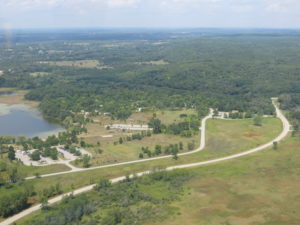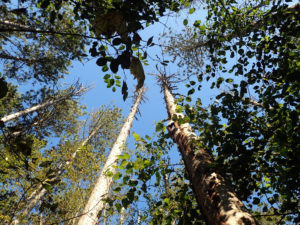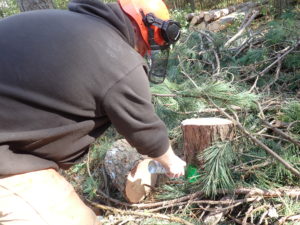By Kyoko Scanlon, forest pathologist, Kyoko.Scanlon@wisconsin.gov, 608-235-7532 and Mike Hillstrom, forest health specialist, Fitchburg, Michael.Hillstrom@wisconsin.gov, 608-513-7690
Less than a one-hour drive from Milwaukee, Kettle Moraine State Forest – Southern Unit (KMSU) offers more than 22,000 acres of glacial hills, kettles, lakes, prairie restoration sites, pine woods and hardwood forests. KMSU is one of Wisconsin’s most visited state properties with over 100 miles of mountain biking, horseback riding, snowmobiling and hiking trails. In addition to its ecological and recreational value, KMSU remains a productive and sustainable forest that supports the forest products industry in southern Wisconsin.

Aerial view of KMSU including Ottawa Lake on left.
Despite its beauty, KMSU is host to a silent killer lurking in its woods. Heterobasidion root disease (HRD) is a fungal disease that infects and kills pine and spruce trees. HRD was first identified in Wisconsin in 1993, and by 2002 was found in 10 locations including the KMSU. Initially found in red pine plantations, HRD has subsequently been confirmed in a white spruce plantation and a Norway spruce plantation. Considering that HRD is the most serious disease of pines and spruces in Wisconsin, with no known cure, it is critical to have effective techniques for prevention.

A cluster of dead trees, surrounded by dying trees, indicates the outward spread of the disease.
The best option currently available to prevent HRD infection is to apply a protective fungicide to freshly cut stumps at the time of tree harvest. These stump treatments are required from April to December on the KMSU and all other state lands in Wisconsin. With 250-300 acres of conifers prepared for harvest annually, the risk of further spread of HRD at the KMSU is substantial, and park managers wanted to ensure that stump treatments would be effective at limiting the spread of the disease while allowing for timber harvests to continue.
KMSU property managers, foresters, forest health staff, and researchers from several universities have teamed up on a project to study the effectiveness of a new stump treatment product in Wisconsin. In fall 2019, healthy red pines near HRD infected ones were cut and stumps were treated with either Cellu-Treat®, Rotstop®C or nothing. Cellu-Treat® is a borax-based chemical and Rotstop®C is a biocontrol fungicide that contains spores of a native fungus. When applied to a freshly cut stump, the fungus in Rotstop®C grows into the stump and effectively keeps the HRD fungus out. Although Cellu-Treat® has been used for many years, Rotstop®C has only recently become available. Demonstrating the effectiveness of stump treatments is important in gaining the trust of the forest industry to implement them.

University of Wisconsin – Stevens Point researcher painting a cut stump to differentiate it from other treated stumps.
Wood samples will be collected from these stumps in summer 2020 to evaluate the effectiveness of the fungicides. When the study is completed, hopefully we will have confirmation that Rotstop®C prevents the establishment of HRD on fresh cut stumps in Wisconsin. The willingness of KMSU’s managers and foresters to participate in research projects highlights their proactive approach to HRD management.
In another recent project, forest health staff and university researchers evaluated which species of trees regenerate in pine forests impacted by HRD, including those at the KMSU. We found that these pine stands were mostly regenerating with a mix of red maple, oaks, white pine and red pine but almost 40% of sites also had invasive plants (Demchik et al. 2019). It is likely that HRD-infested pine stands will transition over time to a more diverse mix of species since the pine regeneration is susceptible to HRD. With an improved understanding of forest regeneration in HRD-infested stands, we can now make more informed decisions about how to sustainably manage Wisconsin’s forests.
The next time you visit KMSU, think of many roles that this unique property offers – recreational opportunities, timber resources, wildlife habitat, applied research and more.
For more information about HRD, including a new HRD video and the HRD treatment guidelines, visit the DNR HRD webpage. The article from Demchik et al. (2019) is published in Forest Science.
#NASF100
